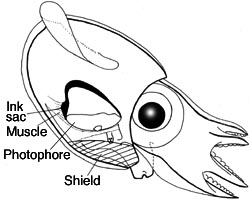Bacteria as cloaking aid
Symbiotic bacteria aren’t just found in land species. The Hawaiian bobtail squid hosts glowing bacteria in its ink sac. The squid is tiny — just 30 millimetres (1.2 inches) long, not counting its tentacles. It hunts in shallow coastal waters. And bacteria give this animal an advantage: camouflage."It's like a Klingon cloaking device," says biologist Margaret McFall-Ngai. She and her research partner, microbiologist Edward Ruby, have studied the roles played by this microbe and its squid host for 25 years. Both scientists work at the University of Wisconsin in Madison.
The bacteria, called Vibrio fischeri (VIH-bree-oh FISH-er-eye), live inside a special light organ in the squid’s ink sac. The microbes glow with the same intensity and color as moon and starlight. That glow masks the presence of the squid as it hunts by night. Without this camouflage, the tiny squid could end up a midnight snack for many fish. But thanks to the microbes, a predator gazing toward the water's surface, where the squid feeds on small shrimp and worms, would see only what appears to be the lights of the moon and the stars, McFall-Ngai explains.
It's little wonder, then, that newborn squid actively collect V. fischeri within seconds of hatching. The bacteria are found in the same areas as these squid. Squid scoop up the microbes with the help of two finger-like protrusions. They’re known as appendages. These appendages — don’t confuse them with tentacles — are located on their light organ, tucked inside the front of the squid’s body cavity.
Thousands of tiny, moving, hairlike features — cilia — cover those protrusions.
The squid makes a circle with its appendages. Their cilia sweep through the sea water with a waving motion. This directs V. fischeri toward three pores on the surface of a squid’s light organ.
Once the bacteria are inside, the squid can control the bacteria's glow. In fact, the squid can even switch off their light. That way, the squid can mimic when a cloud blocks the light of the moon or stars.
The animal does this in two ways. One is by squeezing muscles in the ink sac to cover some of the glowing bacteria. The other is by controlling the amount of oxygen supplied to the microbes. The chemical reaction that makes the bacteria glow requires oxygen. The squid can constrict blood vessels leading to the light organ. That in turn reduces the availability of oxygen.
"These bacteria are small, but they are absolutely essential for proper behavioral function," says McFall-Ngai. Using them for camouflage is a very clever adaptation to life near the sea surface, she points out, "where there is nowhere to hide."
Science News for students
- What is a symbiotic relationship?
- Do you know a land species in which we can find symbiotic bacteria?
- What is the benefit for the bacteria Vibrio fisherie?
- What is the benefit for the Hawaiian bobtail squid?
- Use a drawing to explain how the squid hunts and camouflages thanks to the bacteria.
- Where in the squid do bacteria live?
- How does the squid collect the bacteria?
- Explain how the squid controls the bacteria’s glow.


No comments:
Post a Comment
Note: Only a member of this blog may post a comment.